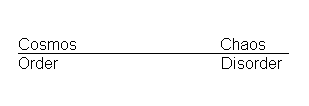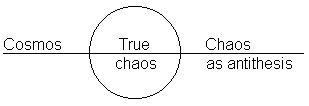1. 1. Three key features in Klee’s thought
Editing some of Klee’s writings, Jurg Spiller
[1] started just with the concept of chaos, which testifies and stresses the importance Klee attached to it.In his writings Klee seems to widely encourage a reading of his ideas about chaos in quite conventional terms; primordial chaos is that peculiar condition of matter just before the creative act imposed the order:
"Chaos is a condition of disorder in the things, a tangle: cosmogonically speaking, it is a primitive, mythic state of the world, from which the ordered cosmos takes shape, gradually or suddenly, by itself or by the intervention of a creator [Italic mine]"
[2]Of course, this holds deep and self-evident connections with the biblical cosmogonies, and we know that according to Klee the creative act has the same valence of a genesis. But just paying some further attention to Klee’s statements we can understand that something else is enclosed in the concept.
First, Klee thinks that the creative process is unfinished, not only because the artist prolongs the creation by means of his activity (which is in itself creation), but even because Nature creates new objects without end (Infinite natural history, said Klee). This implies that chaos, as a primordial state of things, is not overcome with the creation once and for ever, but it is an ever renewed condition of the world, which only temporarily can be overcome, by means of newer and newer creative acts of both nature, with the evolutionary process
[3], and artist:"I begin logically with chaos, it is the most natural start. In so doing I feel at rest because I may, at first, be chaos myself."
[4]
Indeed Klee states that in opposing the binomial chaos – disorder to the binomial cosmos – order (as in Sketch 1) there is something misleading or even wrong: chaos as a pure disorder opposed to the order of the cosmos, is just an artificial and abstract antithesis.
Sketch 1 (facsimile after Klee
[5])

Klee thinks true chaos is something that lays in the between (Sketch 2), something real and material, which sometimes he symbolises with a grey point and or even with the seed or the egg
[5].Sketch 2 (facsimile after Klee
[5])
In fact chaos is essentially the potentiality to become order or life (or even death, according to the opposite directions of the possible stresses).
"The initiate guesses the aboriginal vital point, he has a couple of living atoms and five living, ideal, elemental figurative tools, and he also knows a little grey zone: starting from there it is possible to jump from chaos to order"
[5]Remember now that according to Klee order establishes "gradually or suddenly, by itself or by the intervention of a creator.", to say that Klee openly admits the possibility of a self-established order by means of internal self-established processes (let us for now pass over the amazing and not chance analogy with the concept of self-organisation, peculiar of complex adaptative systems, studied by complexity sciences).
This introduces the second crucial and well-known concept of Klee’s, that of dynamic process. According to his language conventions, we call formation the dynamical process (or the way) that leads to the form, which in turn is the result of the unfolding of natural or creative stresses acting on things.
"Formation theory deals with the ways that lead to form. It is a theory of form, but with an emphasis on the ways that lead to it"
[6]The aim of art, states Klee, is not to show forms in themselves, but instead to openly explain the processes of formation which produce those forms. We can effectively resume by claiming the slogan of the primacy of formation on form.
Finally we must briefly recall a third important element in Klee’s thought which will turn out to be useful for the following discussion: I showed elsewhere
[7] that Klee often uses iterative procedures to construct the overall structure of a painting. Here the term iterative is used in a quite strict sense, to indicate procedures of a repetitive kind, step by step, where the next action (the next step) takes as its input the same output of the previous step, applying on it the same rule that was previously used to obtain that output itself. We can see many such examples by examining his pedagogical writings, for instance the so called progressions (concrete examples will be cited further). Furthermore, as shown in the same paper cited above, we find in Klee's works cases even the term recursion could be properly used in a very strict sense, i.e. in terms of self-reference.